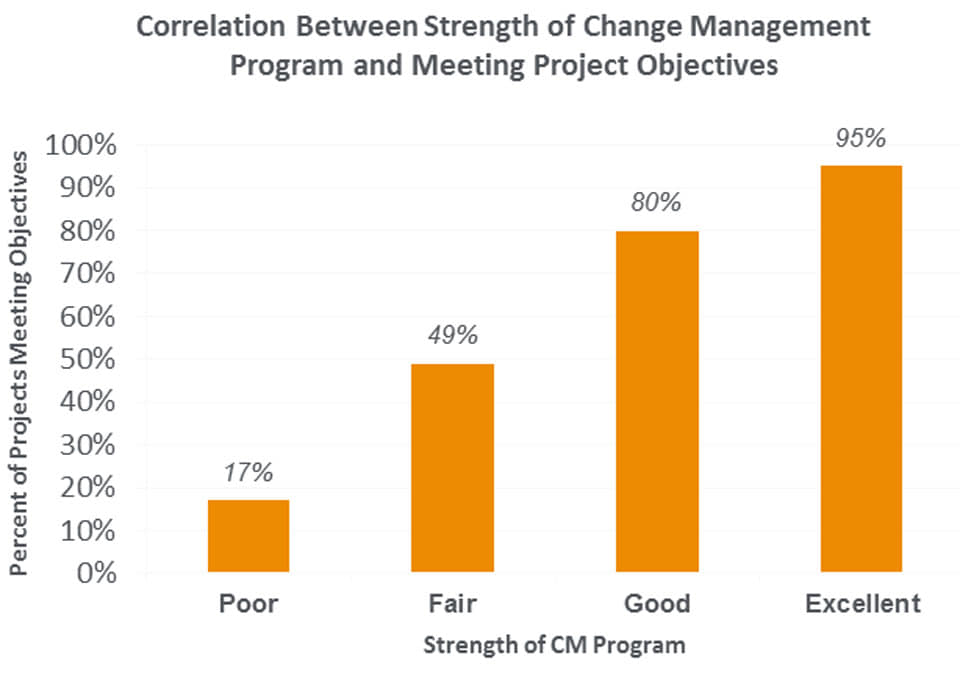
Change Management for the Built Environment: Tips for Communication
Every workplace change, whether it be a completely new office building or simply a change in the way meeting spaces are used or reserved, can cause anxiety to the employee base.
Many projects fail not because they were poorly planned or executed, but because employees are resistant to the change. There is a direct correlation between change management and achievement of project objectives: Prosci’s Best Practices in Change Management found that projects with excellent rated change management plans performed six times better than those with poorly rated plans:
Utilizing change management can help alleviate anxiety, reduce losses to productivity, and even prevent employee turnover, all of which contribute directly to a company’s bottom line.
- The U.S. Department of Labor, BLS, and BOMA find that salaries and benefits total approximately 90% of a company’s workplace costs; presenteeism and absenteeism can be as much as 4% of total workplace costs.
- Turnover costs can be as high as 90 to 200% of an employee’s salary, according to SHRM.
- Gallup estimates that in the United States, active disengagement costs $450 billion to $550 billion per year.
Communication
While it is certainly not the only portion, a key component of any change management plan is communication. Every change is different and requires a specific communication plan; however, the following simple techniques can be applied to nearly any change.
1. Communicate clearly and regularly.
Sharing information (and gathering feedback) is one of the key contributing factors to successful change. Frequent and open communication ranked in the top four contributing factors to success in seven consecutive change management surveys, ranking second in the 2009 and 2011 surveys. How frequently is up to you; however, weekly is recommended for most changes, with monthly communications at a minimum. As the change comes closer, communications should become more frequent. Keep all outgoing communications simple, focused and concise.
2. Tailor the message.
With every change, multiple groups will be impacted; each will experience the change differently. Communications should be tailored to ensure that each group is aware of how they will be impacted, what to expect, and how to prepare. Also remember, what is compelling for one person is not necessarily compelling for everyone.
As part of this process, take time to acknowledge rumors. Instead of allowing misinformation to percolate throughout the staff, directly address issues as they arise while maintaining a positive message.
3. Communicate the vision from an executive level.
Employees need to know the business reason for the change. This should be clearly communicated, preferably by top executives. This communication should share the vision of the executive leadership and tie the reason for the change to the overall mission of the company.
Executives must be committed to the change and communicate this commitment; Boston Consulting Group finds that one of the key factors for successful change is leadership’s commitment to the change.
4. Managers are the preferred sender of personal messages.
While the overarching vision for change should come from the executive level, messages about “what’s in it for me” typically are best received from a direct supervisor: 70% of employees indicate that the preferred sender of personal messages is the employee’s direct supervisor (Best Practices in Change Management).
5. And, communicate clearly and regularly.
(In case you had already forgotten.) Keep in mind that people have different learning styles; Consider models such as David Kolb’s Learning Styles Model and Experiential Learning Theory (ELT); Howard Gardner’s
Multiple Intelligence Theory; and Neil Fleming’s Visual, Read/Write, Auditory, Kinesthetic (VARK) model.
Consider using multiple forms of media to help get the message out. Hundreds of vehicles are available, such as emails, posters, intranet websites, meetings, announcements, to name just a few. Messages should be repeated five to seven times to ensure that they not only reach, but are also absorbed by the intended audience.
While communication is only a part of the overall change management and employee engagement process, getting it right can help your company’s change. For more information on change management, check out my previous posts on Making the Case for Change and Getting Started.
Stay tuned for our next post on lessons learned. Good luck with your change!

